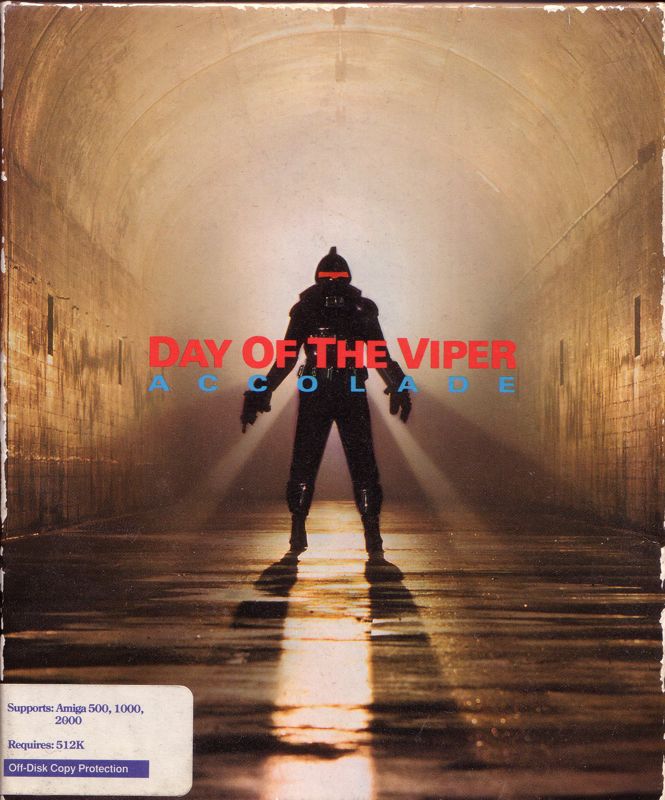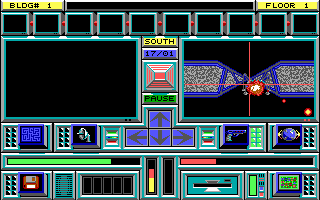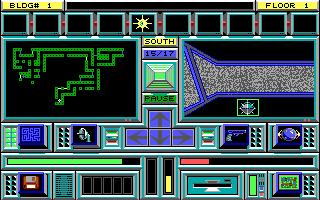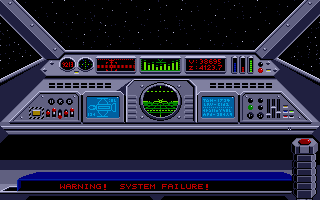Retro Replay Review
Gameplay
Day of the Viper delivers a deceptively simple premise that quickly unfolds into a tense, puzzle-driven shooter. You pilot a Viper V droid through 25 intricately designed levels, each automatically mapped as you explore the station. Movement and rotation are handled via on-screen directional arrows, giving you clear feedback on your orientation in this first-person 3D environment. As you progress, you’ll quickly learn to toggle between cautious exploration and sudden bursts of combat as small robotic enemies close in from every corridor.
(HEY YOU!! We hope you enjoy! We try not to run ads. So basically, this is a very expensive hobby running this site. Please consider joining us for updates, forums, and more. Network w/ us to make some cash or friends while retro gaming, and you can win some free retro games for posting. Okay, carry on 👍)
The core loop revolves around locating floppy disks scattered throughout the base, which serve as the keys to reactivating the planet’s defenses against the Gar computer. Rather than presenting open battlegrounds, each sector feels like a self-contained labyrinth. You’ll spend as much time deciphering level layouts and marking points of interest on the in-game notepad as you will blasting away at one of the 33 enemy robot types. The notepad feature is indispensable for keeping track of disk locations, security codes, and locked turbolift destinations.
Combat itself is surprisingly varied. Some enemies charge at you relentlessly, while others employ ranged attacks that force you to strafe between narrow conduits. Ammo and energy reserves are scarce, pushing you to choose your engagements wisely. The tension of not knowing whether you’ve scouted every nook or found that last crucial disk makes each level a rewarding puzzle. When you finally reach the disk vault on a given floor and slip it into your drive, there’s a palpable sense of achievement that keeps you moving forward.
Graphics
Visually, Day of the Viper embraces its late-’80s roots with blocky sprites and flat-shaded corridors, yet it succeeds in conveying a claustrophobic, high-tech atmosphere. Walls and floors are defined by simple textures that echo classic sci-fi aesthetics. While you won’t be wowed by polygon counts, the clear color coding of doors, consoles, and danger zones ensures you never feel lost for long.
Enemy robots exhibit basic animation loops, but their distinct silhouettes make it easy to distinguish between melee attackers, floating gunships, and turret drones. The first-person viewpoint occasionally suffers from a stilted frame rate, particularly when multiple enemies converge on screen, yet this quirk only adds to the game’s retro charm. Directional arrows overlayed on the HUD not only guide your movement but also emphasize the grid-based nature of the levels, reinforcing a sense of methodical exploration.
Special effects are minimal, limited mainly to brief muzzle flashes and flickering warning lights when alarms are triggered. That said, the game shines brightest when you open a secured door to reveal a turbine shaft or an abandoned control room—small touches like animated console panels and rotating ceiling fans give each environment life. Overall, Day of the Viper’s graphics strike a balance between functionality and style, ensuring you’re focused on the action and the puzzle at hand.
Story
At its core, Day of the Viper spins a classic rebellion-against-the-machine narrative. The Sun League, a coalition of freedom fighters, has long struggled to overthrow the oppressive Gar computer that now rules the planet. When they manage to infiltrate the planet’s orbital defense base, they entrust you with the command of a prototype Viper V droid—your only hope of rebooting the system and turning the tide of war.
Story beats are delivered sparingly, primarily via brief text drops when you access certain consoles or slot in a found floppy disk. This minimalist approach allows the backstory to emerge organically, as each new sector reveals corrupted logs about the Gar’s rise to power or frantic memos left by previous pilots. While you won’t find deep character development here, the high-stakes premise is enough to keep your pulse racing as you dart through darkened hallways.
The tension ramps up with every floppy disk you acquire: each one brings you closer to confronting the Gar’s central core. As you trigger new sections of the base or unlock hidden turbolifts, you sense the enemy AI scrambling to adapt, dispatching more aggressive robots into your path. By the final levels, the once-quiet terminals are bathed in red alert, and the base’s layout feels increasingly labyrinthine—an apt metaphor for the Gar’s convoluted logic that you are bent on unraveling.
Overall Experience
Day of the Viper stands out as an early example of first-person 3D exploration merged with action and strategy. Its deliberate pacing rewards players who take stock of each area, use the notepad to record vital clues, and manage resources carefully. The game’s difficulty curve grows steadily challenging, making every floppy disk you deposit in the base’s mainframe feel earned.
Replay value is higher than one might expect: hidden rooms, optional side corridors, and varying enemy spawn patterns invite multiple playthroughs. The straightforward control scheme, while dated by modern standards, lends itself to quick mastery, so you’ll feel comfortable testing new approaches to each level. Fans of retro shooters and puzzle-adventure hybrids will find plenty to admire in the game’s blend of methodical exploration and sudden firefights.
Despite its age, Day of the Viper retains a unique charm. Its retro graphics, tense sound design, and simple yet engrossing story combine to form an experience that still feels fresh thanks to its unrelenting drive toward that final confrontation with the Gar computer. If you’re looking for a vintage gem that challenges both your reflexes and your wits, this classic deserves a spot in your collection.
 Retro Replay Retro Replay gaming reviews, news, emulation, geek stuff and more!
Retro Replay Retro Replay gaming reviews, news, emulation, geek stuff and more!









Reviews
There are no reviews yet.